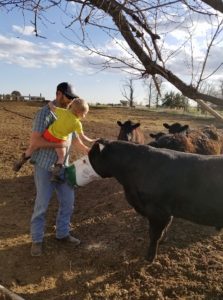If you have kids, you know their favorite question is “Why?”
Since one of my 3-year-old’s recent questions is one that is commonly asked from those non-farm kids among you too, I thought I would answer it today.
“Mom, why do cows eat corn?”
The simple answer for my 3-year-old: because cows are unique or different from other animals. They have a “special” stomach that has many (four) compartments (unlike the human stomach that only has one) that is designed to digest different materials like grass, corn stalks, cottonseeds and hay. They actually can eat things that humans can’t.

Our 3-year-old feeding the bull corn out of a bucket with his dad.
A More In-Depth Answer
The more complicated answer for those of us able to comprehend bigger terms: Even though most cattle spend most of their life grazing on grass (contrary to what media leads you to believe), many ranchers choose to have their cattle spend the last few months of their lives also eating grain and other roughages (fibrous materials such as grass, corn stalks (the leftovers after a cornfield is harvested), cottonseeds (the leftovers after cotton is harvested), alfalfa and hay). This allows them to grow more efficiently, reducing the total amount of time and resources used to get that beef to the grocery store or your favorite restaurant for consumers.
Because of the special stomach of a cow, we call them a ruminant. Other ruminant animals include sheep, deer and giraffes. Yes giraffes! Who knew they had something in common with a cow?
But it gets even more interesting–cattle have bacteria and protozoa (single-celled microorganisms that feed on organic matter) residing in their stomachs that release nutrients that can be utilized. Humans do not have these specific bacteria or protozoa. See–this is why I had to put the explanation for my 3 -year-old in a little simpler terms!
So, what do these specific bacteria and protozoa and four-compartment stomachs have to do with anything? Well, it allows a cow, unlike humans or other non-ruminant animals, to consume feeds–like the leftovers from corn (corn gluten, distillers grains), brewers grains, leftovers from potatoes, soybean hulls, citrus pulps and other products that are considered leftovers and would just be thrown away or end up in landfills–and utilize them as nutrient-rich foods.
Feeding cattle corn for the last few months before harvest serves a critical role in the development of nutritious beef. A higher-concentrate diet means that the feed gets converted into muscle with a high level of marbling (think of that tasty steak that you love to eat). Corn is a good source of energy in the form of carbohydrates, just like humans eat carbs for energy.
Cattle are Upcylers
Do you know what that means? Cows can basically take leftovers and recycle them. We use the term “upcyle” because instead of just recycling material, they are actually upgrading human inedible material or food waste into high-quality protein and essential micronutrients.
According to a recent publication from the National Academies of Sciences, Engineering, and Medicine, only 9.3% of total feed required to finish one conventional, grain-finished beef animal in the US is grain. The other 90.7% is mostly grass and hay and the other leftovers mentioned above.
Biology is fascinating! Cattle actually enhance the sustainability of other industries by using byproducts from production! And, the feed that they eat is largely not in competition with the human food supply. I’ll leave the munching on cottonseed and sugar beet pulp to the cows!
I hope this helps explain why cows eat corn, along with the other maybe seemingly strange things they eat. As always, if you have more questions, please ask!








Leave a Reply